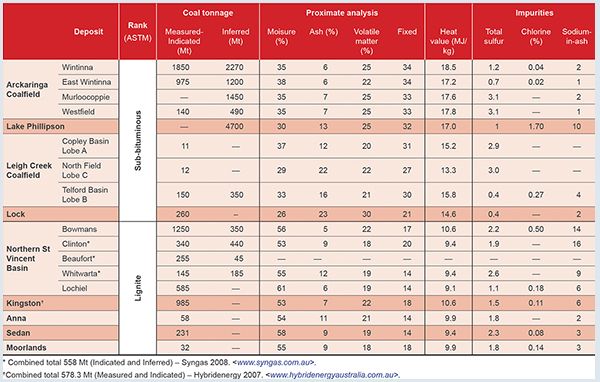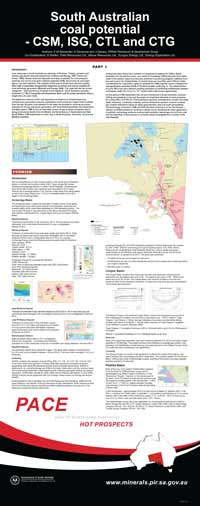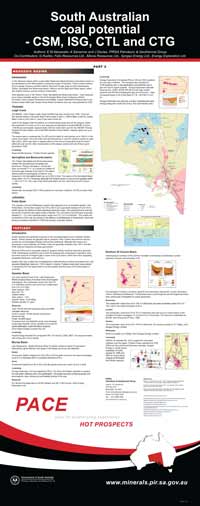Coal is a combustible rock of organic origin composed mainly of carbon, hydrogen and oxygen, with lesser amounts of nitrogen, sulfur and other elements. Varying amounts of water are always present, as are grains of inorganic matter that form an incombustible residue known as ash.
Coal is formed by the accumulation and decomposition of plant-derived organic remains. Burial and degradation of plant material is accompanied by extensive biochemical reactions which result in the formation of peat. The combined effects of time, temperature and pressure result in coalification - the development of coal from peat.
The degree of coalification, referred to as the rank of the coal, increases from lignite (brown coal) through sub-bituminous coal, bituminous coal and anthracite (together known as black coal). With increasing rank there is a decrease in water content and an increase in carbon content.
The main uses of coal are:
- as a fuel in electricity generation (black and some brown coal)
- for making coke (certain types of black coal) which is used in iron and steel making.
Other uses of black coal include:
- cement production
- other manufacturing (used as a heat source)
- making plastics.
Brown coal is also used to make briquettes for domestic heating.
In 1997, world production of black coal was approximately 3.8 billion tonnes; Australia was the sixth largest producer, contributing 220 Mt (6%). The main producers are the USA and China (60%).
Most of Australia’s black coal is mined in New South Wales and Queensland with approximately 70% of this being exported, mainly to Japan, making Australia the world’s largest exporter of black coal. In 1997, approximately 60 Mt of brown coal were mined in Australia (Victoria), mostly for local power generation.
Coal in South Australia
Until recently, South Australia produced approximately 2.7 Mt of low-grade sub-bituminous black coal for power generation from a single mine at Leigh Creek. With the closure of this mine in 2015 there are no longer any operating coal mines within the State.
The first discovery of coal in South Australia was the very small occurrence of lignite near Pidinga, found in 1885. Coal has subsequently been found widely distributed throughout the State in sedimentary basins ranging in age from Permian to Tertiary.
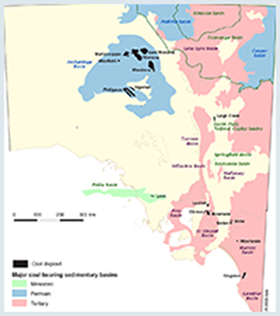 Coal location map (PDF) | 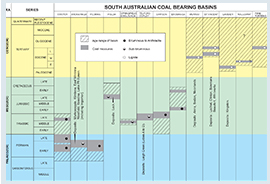 Coal bearing basin age and rank (PDF) |
The majority of this coal is of low rank and poor quality, often high in impurities and generally expensive to extract, but most is suitable for local electricity generation (in situ tonnage and quality). Coking coal for ore smelting at Whyalla and Port Pirie is imported by ship from the eastern States. A small amount of high-grade steaming coal is also imported for rural industries and steam-train use; brown coal briquettes are imported from Victoria for domestic and industrial use.
The following table gives in situ tonnage and quality for coal deposits in South Australia.
The technology exists to produce both synthetic natural gas and oil from coal, but commercial production is uneconomic at current petroleum prices. This situation may change in the future, depending on the world crude oil price and improvements in coal conversion technologies.
Permian
Substantial resources of Permian sub-bituminous coal have been delineated in the Arckaringa Basin in the state’s central north. Six deposits have been discovered, four of which comprise the Arckaringa Coalfield (Wintinna, Westfield, East Wintinna and Murloocoppie), with the other two being the Phillipson (including Penrhyn) Coalfield and Weedina deposit. These multi-seam deposits are generally flat lying and are covered by 30–300 m of poorly consolidated and frequently water-saturated Jurassic and Cretaceous sandstone and mudstone comprising the Eromanga or ‘Great Artesian’ Basin. The coal seams, which reach cumulative thicknesses of up to 25 m, occur in the upper part of the Early Permian Mount Toondina Formation and are interbedded with siltstone, carbonaceous mudstone and minor sandstone.
During the course of petroleum exploration, coal seams up to 25 m thick have been intersected in Early Permian sediments of the Cooper and Pedirka Basins at depths ranging from 1300 to 4000 m. In the Cooper Basin, coal seams are often interbedded with fluvial sandstones which act as reservoirs for gas and gas liquids. This is the highest ranking coal found in South Australia (bituminous to anthracite) and is similar to many of the Queensland and New South Wales coals. Resources are estimated at hundreds of billions of tonnes but mining is not feasible. In situ gasification, following depletion of natural gas and oil reserves, is a possible technological challenge for the future.
Triassic
The only producing coalfield in South Australia was near Leigh Creek, where coal occurs in the Late Triassic part of a Late Triassic – Early Jurassic sequence of freshwater sediments. The low-grade sub-bituminous coal occurs in five discrete basins over a distance of 20 km (Fig. 2). Lobe B (Telford Basin) is the largest and hosted large scale mining operations for over 50 years up until 2015 when mining ceased. The coal seams are interbedded with mudstone, siltstone and sandstone, and range in thickness from a few metres up to 18 m for the main seam in Lobe B. Basin sediments dip radially towards the centre to form regular saucer-shaped depressions.
Coal was discovered in the Copley Basin near Leigh Creek while excavating a railway dam in 1888. In 1943, open-cut mining began in the Telford Basin but was transferred in 1956 to smaller deposits at North Field, where coal was easier to extract. The best coal in these deposits was worked out by 1976, after which operations returned to the larger but deeper deposit in the Telford Basin. Coal was then continuously mined from the Telford Basin at a rate of approximately 2 Mt/year by open-cut methods up until 2015 when mining operations ceased. The mining operation involved drilling, blasting and removal of overburden and coal by shovels and trucks. After mining, the crushed coal was railed to the Port Augusta power stations where it was used as fuel contributing to the state's electricity needs.
Due to the steeply dipping seams, the economic recovery of coal by open cut methods was limited to around 100 Mt (20% of the estimated coal resource), to a maximum depth of around 250 m. To extend the economic life of the mine, ‘terrace’ or haulback mining was implemented in 1990, which offered considerable savings over the previous strip mining operation. In the terrace mining method, overburden removed to expose the coal was used to backfill areas where mining has been completed.
Basins similar in age, structure, size and geology to those near Leigh Creek are also known at Springfield and Boolcunda, 300 km north of Adelaide, but the coal is generally thin and often deep, making these basins uneconomic. The Springfield Basin also contains coal of Permian age within the basal conglomerate sequence.
Jurassic
Low-grade sub-bituminous coal of Late Jurassic age was discovered in 1976 during exploration by the Department of Mines and ETSA near Lock in the Polda Basin of central western Eyre Peninsula. The high-ash coal occurs as a number of gently dipping seams interbedded with sand and clay of the Polda Formation, and is confined to a narrow east–west-trending basin, 2–4 km wide and 15 km long. Cumulative coal thickness is generally 5–15 m and usually occurs beneath 50–130 m of Tertiary and Quaternary sand, clay and gravel. The high ash content renders the coal difficult to use in conventional power stations. To date, the poor coal quality, seam variability and presence of groundwater aquifers have made development of this deposit unattractive.
Tertiary
South Australia has large resources of low-rank brown coal (lignite) of Middle to Late Eocene age, distributed widely in Tertiary sedimentary basins in the southern part of the State. Deposits in the northern St Vincent Basin (Bowmans, Lochiel, Beaufort, Whitwarta and Clinton) are characterised by north–south-trending faults which controlled sedimentation and the accumulation of lignite. The lignite occurs as multiple flat-lying seams with cumulative thicknesses generally up to 15 m (up to 25 m at Bowmans). The seams occur in unconsolidated, carbonaceous sand and clay at the base of the Tertiary succession, and are overlain by 20–150 m of unconsolidated Tertiary and Quaternary clay, sand and silt.
Other major lignite deposits have been discovered near Kingston in the South-East of the State, and at Sedan, 80 km northeast of Adelaide. Smaller deposits are also known at Moorlands and Anna. Cumulative seam thicknesses for these range from 8 to 12 m and occur within Tertiary sediments of the Murray Basin. These sediments are overlain by 15–92 m of limestone, silt and clay of Tertiary and Quaternary age.
All the lignite deposits are high in moisture, sulphur, sodium and chlorine, which can cause slagging, fouling and corrosion of boilers in conventional power stations. Pilot combustion testing and boiler design work have been undertaken using bulk samples extracted from trial pits at Bowmans and Lochiel, and from 1 m diameter drillcores taken from the Kingston, Lochiel and Sedan deposits. In addition to the poor quality of the lignite, the seams are interbedded and covered by essentially unconsolidated sediments and water-saturated sand which would require dewatering prior to mining.
Although there are obvious disadvantages, development of these deposits for power generation would have advantages in that they are conveniently located in relation to centres of demand for electricity and could be mined cheaply by open-cut methods. Other possible uses being investigated include gasification, liquefaction, briquetting and pretreatment processes to upgrade the lignite by removing salt, sulphur and water.
Posters presented to the South Australian Resources and Energy Infrastructure Conference (SAREIC) 2009
South Australian coal potential - CSM, ISG, CTL and CTG Part 1 (PDF 63KB) | South Australian coal potential - CSM, ISG, CTL and CTG Part 2 (PDF 584KB) |
Additional Reading
Earth Resources Information Sheet Coal deposits in South Australia (PDF 3 MB)
Ward, C.R., Harrington, H.J., Mallett, C.W. and Beeston, J.W. (Eds), 1995. Geology of Australian coal basins. Geological Society of Australia. Coal Geology Group. Special Publication, 1.
Drexel, J.F. and Preiss, W.V. (Eds), 1995. The geology of South Australia. Vol. 2, The Phanerozoic. South Australia. Geological Survey. Bulletin, 54.
Caplygin, S. and Kwitko, G., 1992. The discovery and development of coal in South Australia. Paper prepared for the AUSIMM Annual Conference, 1992 (unpublished).


